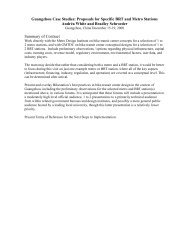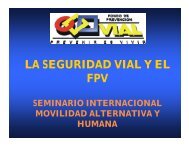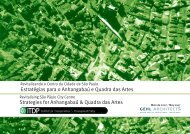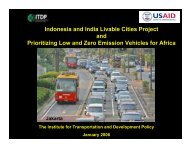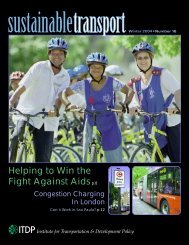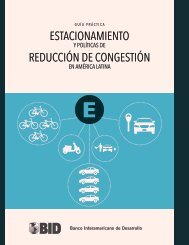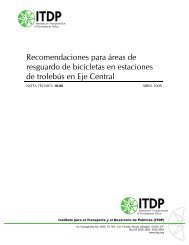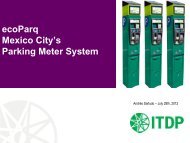BRT Standard - ITDP | Institute for Transportation and Development ...
BRT Standard - ITDP | Institute for Transportation and Development ...
BRT Standard - ITDP | Institute for Transportation and Development ...
Create successful ePaper yourself
Turn your PDF publications into a flip-book with our unique Google optimized e-Paper software.
The <strong>BRT</strong> <strong>St<strong>and</strong>ard</strong> Version 1.0 9<br />
ridership of a planned new <strong>BRT</strong> system when more<br />
sophisticated modeling data is unavailable.<br />
Similarly, the <strong>BRT</strong> <strong>St<strong>and</strong>ard</strong> may be a useful<br />
element of project appraisal as a way of testing<br />
the credibility of speed improvements or other<br />
per<strong>for</strong>mance claims made as part of a more<br />
systematic “per<strong>for</strong>mance-based” metric, such<br />
as the U.S. Federal Transit Administration’s<br />
cost-effectiveness analysis or the internal rateof-return<br />
analysis required by the development<br />
banks during project appraisal, but it is not<br />
a replacement <strong>for</strong> these appraisal tools.<br />
The <strong>BRT</strong> <strong>St<strong>and</strong>ard</strong>: Pilot Process<br />
The <strong>BRT</strong> <strong>St<strong>and</strong>ard</strong> version 1.0 is a pilot being<br />
tested by the <strong>BRT</strong> <strong>St<strong>and</strong>ard</strong> Committee during<br />
the first half of 2012. Over the past year, the<br />
committee considered a wide range of scorecard<br />
indicators. Many of these were included in the<br />
final scoring system, but some were determined<br />
to be beyond the scope of the scorecard.<br />
L<strong>and</strong> use <strong>and</strong> green architecture in station<br />
design, <strong>for</strong> example, are recognized as important<br />
<strong>and</strong> should be encouraged in all <strong>BRT</strong> systems, but<br />
are not included. For l<strong>and</strong> use <strong>and</strong> transit-oriented<br />
development, LEED ND’s certification scheme is<br />
recommended as the measurement tool <strong>for</strong> l<strong>and</strong><br />
use-related elements of a <strong>BRT</strong> project.<br />
After much debate, it was decided not to<br />
award any points <strong>for</strong> good system-management<br />
structures, despite the fact that there was a<br />
consensus that many of the most important<br />
elements of <strong>BRT</strong> are related to high-quality<br />
management. While these issues are critical,<br />
some of them are too controversial or too context<br />
specific to achieve unanimity <strong>for</strong> an international<br />
st<strong>and</strong>ard scoring system. There are many ways<br />
that the system operator can achieve higherquality<br />
per<strong>for</strong>mance through different contract<br />
structures or per<strong>for</strong>mance metrics in various<br />
regulatory environments, <strong>and</strong> we were unable to<br />
craft a metric to include in this scoring system.<br />
Ultimately, the <strong>BRT</strong> <strong>St<strong>and</strong>ard</strong> has two main uses:<br />
1 To evaluate systems already built to<br />
recognize those systems that are of the<br />
highest quality. These scorings will be<br />
released once a year <strong>and</strong> will be used as a<br />
means to compare systems <strong>and</strong> reward <strong>and</strong><br />
celebrate those that have made politically<br />
courageous <strong>and</strong> technically difficult<br />
decisions.<br />
2 To be used by planners, decision makers,<br />
<strong>and</strong> concerned citizens as a way to evaluate<br />
<strong>BRT</strong> corridors in the planning phase. It will<br />
function as a mechanism to underst<strong>and</strong><br />
how close plans come to international best<br />
practice <strong>and</strong> to illuminate where changes<br />
could be made to improve the system.<br />
After the 2012 testing period, the committee will<br />
convene again <strong>and</strong> review comments <strong>and</strong> scoring<br />
<strong>and</strong> make adjustments. Finalization of the <strong>BRT</strong><br />
<strong>St<strong>and</strong>ard</strong> will happen by October 2012, with the<br />
goal of releasing the <strong>BRT</strong> <strong>St<strong>and</strong>ard</strong> in 2013.<br />
The <strong>BRT</strong> <strong>St<strong>and</strong>ard</strong> Committee looks <strong>for</strong>ward<br />
to making this an even stronger tool <strong>for</strong> creating<br />
better <strong>BRT</strong> systems <strong>and</strong> encouraging better public<br />
transport that benefits cities <strong>and</strong> citizens alike.





